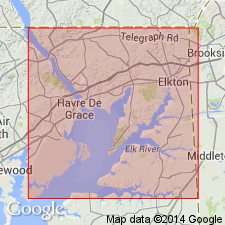
- Usage in publication:
-
- Frenchtown diorite
- Modifications:
-
- Named
- Dominant lithology:
-
- Diorite
- AAPG geologic province:
-
- Piedmont-Blue Ridge province
Summary:
Name Frenchtown diorite used to refer to gabbro diorite near Frenchtown, Cecil Co., MD. Age unknown.
Source: GNU records (USGS DDS-6; Reston GNULEX).

- Usage in publication:
-
- Frenchtown Member*
- Modifications:
-
- Revised
- AAPG geologic province:
-
- Piedmont-Blue Ridge province
Summary:
Frenchtown diorite of Grimsley (1894) adopted as Frenchtown Member of James Run Formation (of Glenarm Group) as redefined in this report. Unit includes green, dark- to medium-gray, and light gray interbedded and multiply folded metavolcanic, metavolcaniclastic, and metavolcanic epiclastic rocks. Thickness approximately 915 m. Overlies Principio Furnace Member (new) of James Run; probably partly equivalent to Little Northeast Creek Member (new) of James Run. Underlies Gilpins Falls Member of James Run. Age is early Paleozoic.
Source: GNU records (USGS DDS-6; Reston GNULEX).
For more information, please contact Nancy Stamm, Geologic Names Committee Secretary.
Asterisk (*) indicates published by U.S. Geological Survey authors.
"No current usage" (†) implies that a name has been abandoned or has fallen into disuse. Former usage and, if known, replacement name given in parentheses ( ).
Slash (/) indicates name conflicts with nomenclatural guidelines (CSN, 1933; ACSN, 1961, 1970; NACSN, 1983, 2005, 2021). May be explained within brackets ([ ]).

